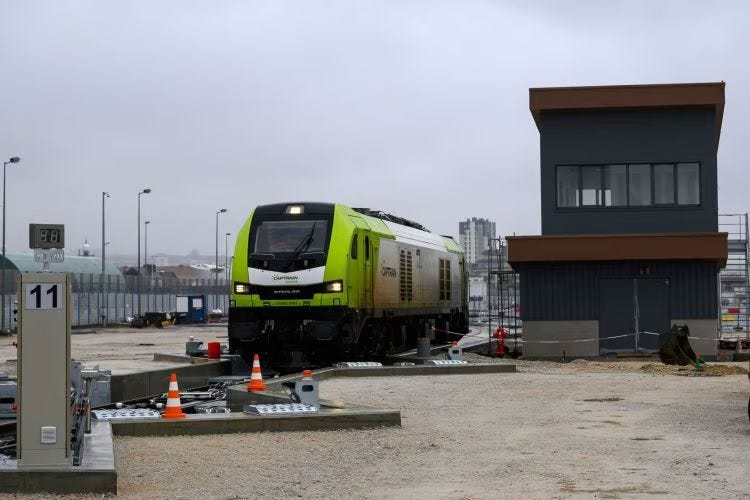How the Cherbourg-Bayonne rail highway creates a sustainable UK-Spain corridor

A new rail-ferry combination linking Normandy with the French Basque Country is transforming freight flows between the British Isles and Iberian Peninsula. The Cherbourg-Bayonne rail highway, operated by Brittany Ferries and Captrain, demonstrates how multimodal transport can reduce road congestion while maintaining supply chain efficiency.
The concept is straightforward yet innovative: unaccompanied trailers arriving by ferry from the UK and Ireland at Cherbourg are loaded onto specialized rail wagons for the 1,000-kilometer journey to Bayonne-Mouguerre near the Spanish border. From there, trucks complete the final leg to destinations across Spain and Portugal, avoiding the need to drive through the entire length of France.
The technical solution
The service employs Modalohr wagons, a French-designed system featuring pivoting pockets that allow standard road trailers to be loaded horizontally without cranes. Each wagon has double pockets, accommodating two trailers. Currently operating with 18 wagons per train (36 trailers), capacity will expand to 21 wagons (42 trailers) by 2026.
The loading process takes approximately two hours. Trailers arriving on morning ferries from Portsmouth, Poole, or Rosslare are driven onto the pivoting platforms at Cherbourg's new EUR 17 million rail terminal. The platforms rotate to align with the track, securing the trailers for rail transport. The evening departure at 19:15 reaches Bayonne-Mouguerre the following morning at 11:00, perfectly timed for onward road delivery to Spanish destinations.
Strategic positioning and cargo expansion
The timing is particularly crucial for the UK-Spain perishables trade. Spanish fruit and vegetable exports to the UK, running from October to May, represent a significant one-way traffic flow that has traditionally relied entirely on road transport. The rail highway's reliability offers producers guaranteed delivery windows critical for fresh produce.
Fabrice Turquet, Brittany Ferries' commercial director for Iberian markets, identifies this seasonal trade as key to achieving the target 70% capacity utilization. The service's punctuality advantage over road transport makes it particularly attractive for time-sensitive goods.
Beyond perishables, the operator is finalizing authorization to carry hazardous goods. This expansion opens new market segments while maintaining safety standards. The industrial and automotive sectors already represent core customers, with manufacturers using the service for just-in-time deliveries between production facilities in Spain and assembly plants in the UK.
Environmental and infrastructure impact
Operating five round trips weekly, rising to six or seven by 2026, the service will remove up to 30,000 trucks annually from French roads. This translates to approximately 20,000 tonnes of CO2 saved. For trucking companies facing increasing carbon taxes and environmental zones in French cities, the rail option provides both compliance and cost benefits.
The service also alleviates pressure on the congested A10 and A63 motorways, particularly during summer holiday periods. By transferring long-distance freight to rail, remaining road capacity can better serve local and regional transport needs.
Brexit and operational advantages
Post-Brexit trade complexity has boosted the service's appeal. Consolidated handling of trailers at two points simplifies documentation compared to individual truck crossings. The rail terminals' dedicated customs facilities streamline clearance, reducing administrative burden for logistics companies.
The service helps address the chronic shortage of drivers willing to undertake long-distance international routes. By using rail for the French transit, available drivers can focus on shorter, more efficient final-delivery segments in their home markets.
Future development
The Cherbourg-Bayonne rail highway represents part of France's broader modal shift strategy, supported by national and EU funding programs. As the service proves its commercial viability, it could model similar routes elsewhere in Europe where geography creates natural corridors between production and consumption centers.
Success in achieving consistent capacity utilization in both directions could demonstrate that sustainable transport solutions need not compromise commercial efficiency – a crucial factor in achieving the EU's goal of shifting 30% of road freight over 300 kilometers to rail by 2030.

